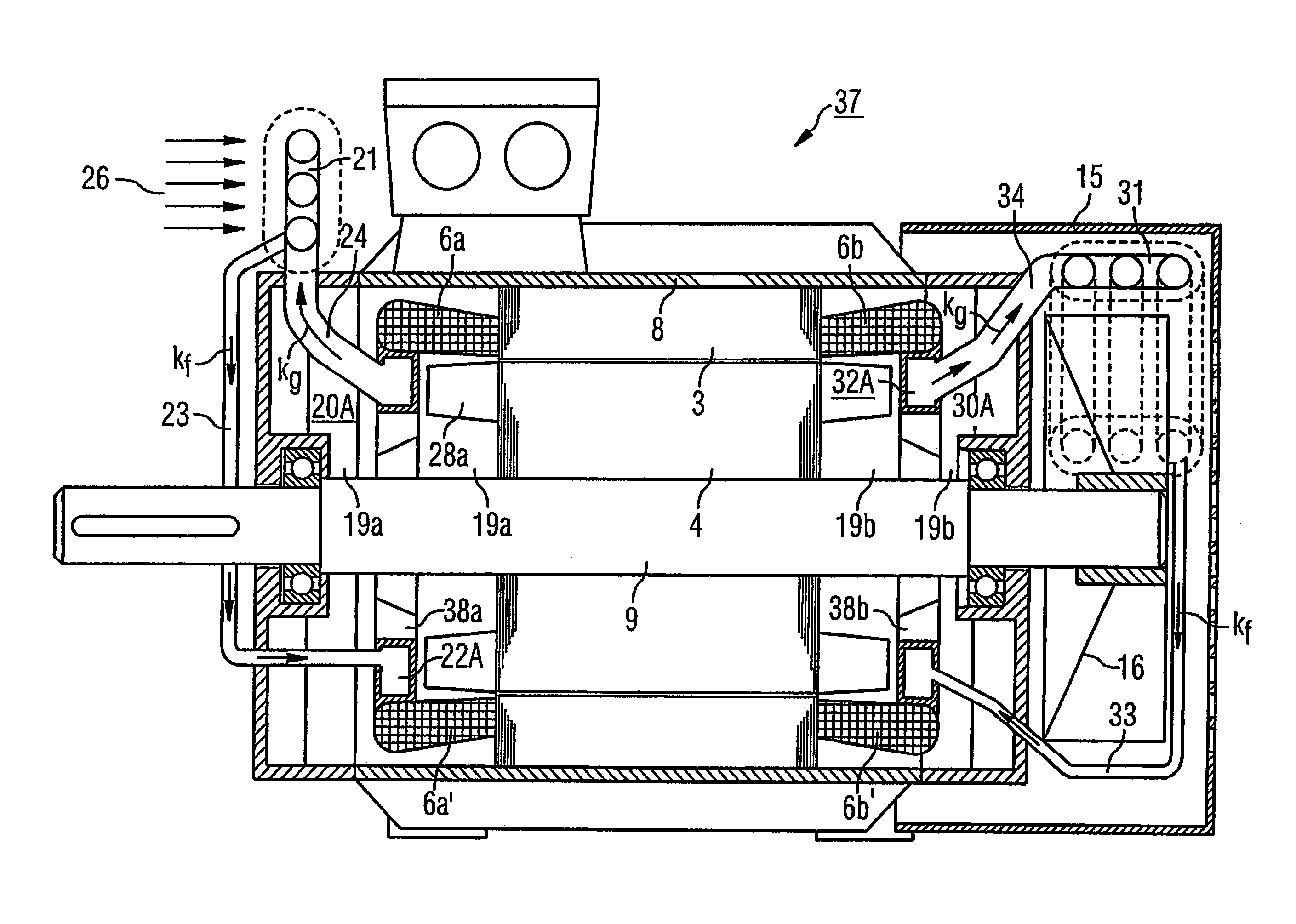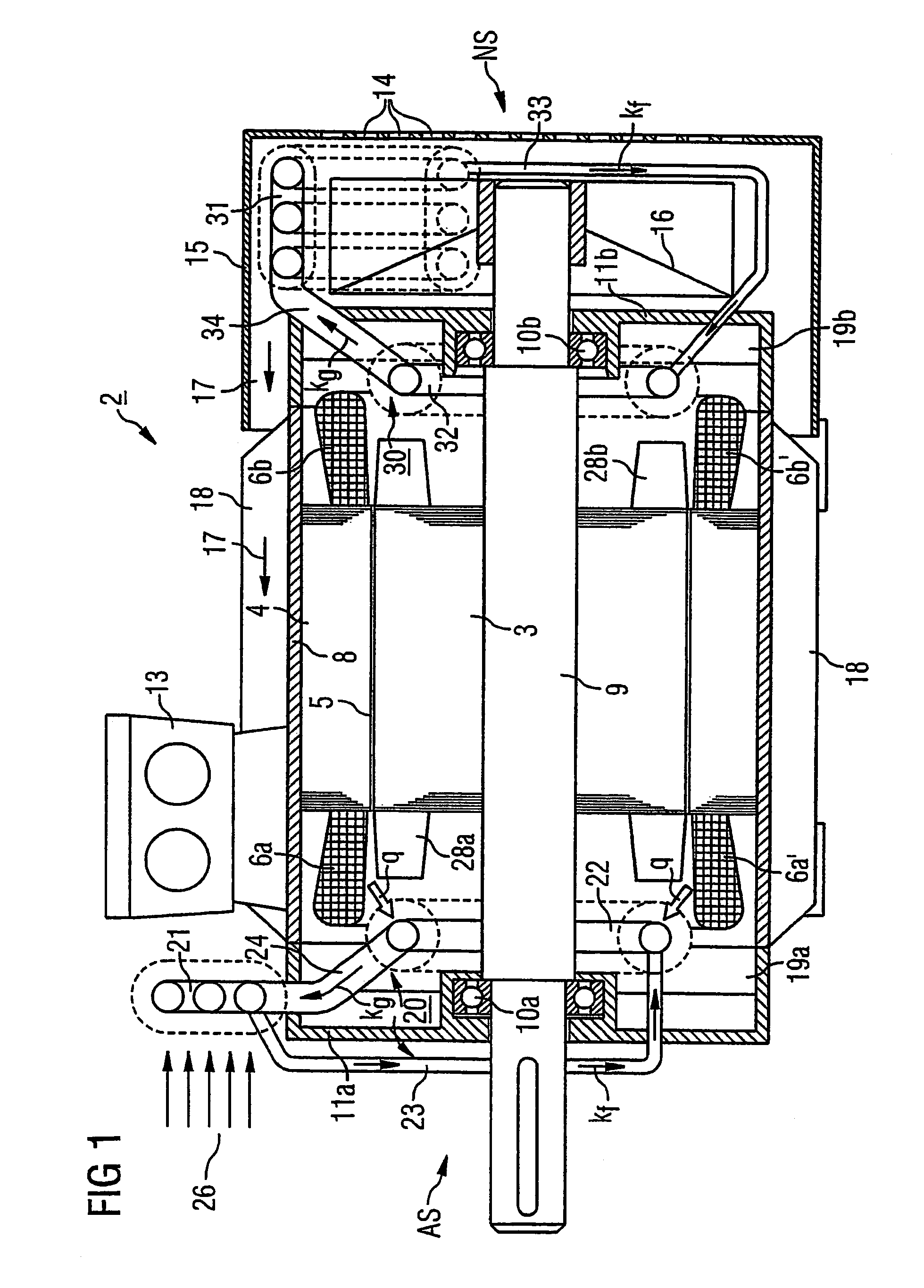Electric machine with thermosiphon-type cooling system
a cooling system and thermosiphon technology, applied in the direction of windings, magnetic circuit rotating parts, magnetic circuit shape/form/construction, etc., can solve the problems of unfavorable bearing heating, unfavorable bearing heating, and generation of unwanted heat by air stream itself, so as to achieve the effect of preventing inadmissible bearing heating
- Summary
- Abstract
- Description
- Claims
- Application Information
AI Technical Summary
Benefits of technology
Problems solved by technology
Method used
Image
Examples
first embodiment
[0032]Turning now to the drawing, and in particular to FIG. 1, there is shown a sectional view of an electric machine according to the present invention; generally designated by reference numeral 2 and having a rotor core 3 formed of a plurality of stacked laminations, and a stator core 4 formed of a plurality of stacked laminations in distanced surrounding relationship to the rotor core 3 to define a narrow air gap 5 therebetween. The stator core 4 includes a stator winding which terminates in two end windings 6a, 6a′ and 6b, 6b′ at the axial ends of the stator core 4. In the non-limiting example of FIG. 1, each side includes a single-part or multi-part end winding whose lower portion is situated at a colder environment and is distinguished here by a prime. Immediately adjacent to the stator core 4 in surrounding relationship thereto is a motor housing 8 which is traversed by a rotor shaft 9 having opposite axial ends supported by respective bearings 10a, 10b. The housing 8 is clos...
third embodiment
[0041]Turning now to FIG. 4, there is shown a sectional view of an electric machine according to the present invention, generally designated by reference numeral 39. Parts corresponding with those in FIG. 3 are denoted by identical reference numerals and not explained again. The description below will center on the differences between the embodiments In this embodiment, provision is made for a common thermosiphon-type closed-flow system, generally designated by reference numeral 40. The thermosiphon 40 includes a single condenser 43, disposed anteriorly of the fan wheel 16, and two evaporators 22A, 32A respectively arranged at the axial ends of the electric machine 39 for absorbing heat generated by the end windings 6a, 6a′ and 6b, 6b′. The evaporators 22A, 32A are interconnected by a lower collecting conduit 41 for conducting condensed coolant kf, and an upper collecting conduit 42 for conducting evaporated coolant kg. In other words, the collecting conduit 42 is disposed at a geod...
fourth embodiment
[0044]Turning now to FIG. 5, there is shown a sectional view of an electric machine according to the present invention, generally designated by reference numeral 44. Parts corresponding with those in FIG. 4 are denoted by identical reference numerals and not explained again. The description below will center on the differences between the embodiments. The electric machine 44 has a thermosiphon-type closed-flow system 45 with collecting conduit 41 for liquid coolant kf and collecting conduit 41 for gaseous coolant kg. The collecting conduits 41, 42 are connected to evaporators 22B, 32B which are respectively disposed on the radial outer sides of the end windings 6a, 6a′ and 6b, 6b′ in heat-conducting connection therewith. The thermosiphon 45 includes a condenser 46 on the end surface of the housing 8 at the non-driving side NS of the electric machine 44. For example, the condenser 46 may be directly mounted to or integrated in the end plate 11b. To improve the heat exchange, the cond...
PUM
 Login to View More
Login to View More Abstract
Description
Claims
Application Information
 Login to View More
Login to View More - R&D
- Intellectual Property
- Life Sciences
- Materials
- Tech Scout
- Unparalleled Data Quality
- Higher Quality Content
- 60% Fewer Hallucinations
Browse by: Latest US Patents, China's latest patents, Technical Efficacy Thesaurus, Application Domain, Technology Topic, Popular Technical Reports.
© 2025 PatSnap. All rights reserved.Legal|Privacy policy|Modern Slavery Act Transparency Statement|Sitemap|About US| Contact US: help@patsnap.com



